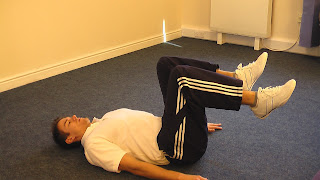Muscle blog series: Part 8: Core stability:
This is the next blog article in
the series and will discuss core stability.
What is Core Stability?
Core stability is defined as the
ability to control the position and motion of the trunk over the pelvis to
allow optimum production, transfer and control of force and motion to the
terminal segment in integrated athletic activities.
Core muscle activity is best
understood as the pre-programmed integration of local, single-joint muscles and
multi-joint muscles to provide stability and produce motion.
This results in proximal
stability for distal mobility, a proximal to distal patterning of generation of
force, and the creation of interactive moments that move and protect distal
joints.
What is the background of core stability?
Core stability started in the
late 1990’s.
It was derived from studies that
demonstrated a change in timing of the trunk muscles in back injury and chronic
lower back pain (CLBP) patients.
However, there have been
assumptions on how this relates to injury prevention and sporting performance:
Certain muscles are more
important for stabilisation of the spine, in particular transverses abdominis
(TrA):
Transverse abdominis is absent or
fused to the internal oblique muscle as a normal variation in some people and
they don’t all have poor core stability and injury! (Gray’s Anatomy 36th
edition 1980, page 555)
That weak abdominal muscles lead
to back pain:
A study no correlation between
sit-up performance and backache. (Fast et al., 1990)
That there is a unique group of
“core” muscles working independently of other trunk muscles:
No single muscle is dominated in
the enhancement of spine stability.
Their individual roles
continuously change across tasks.
Clinically, if the goal is to
train for stability, enhancing motor patterns that incorporate many muscles
rather than targeting just a few is justifiable. (Kavic et al 2004)
If there is no proof that single
muscle activation is possible so why do we try?
Overweight = Poor core stability=Lower
back pain:
Weight gains and obesity are only
weakly associated with Lower back pain. (Leboeuf-Yde, 2000)
So what is the importance of core stability?
Injury Prevention:
The odds of sustaining a lower
back injury increased 2.8 times when a history of lower back injury was present
and increased by 3% with each millisecond of abdominal muscle shut-off latency.
On average, this latency was 14 milliseconds longer for athletes who sustained
lower back injury in comparison to athletes who didn’t! (Cholewicki 2005)
This shows these muscles are
important and they don’t work well with pain
However it isn’t strength it’s
activation and co-ordination:
Standing: Co-contraction of trunk
flexors and extensors are less than 1% Maximal voluntary contraction (MVC)
3% MVC with a 32 Kg weight
During bending and lifting a
weight of about 15 kg co-contraction increases by only 1.5% MVC
So you would have to get very
weak for any problems to arise.
Improving performance:
Evidence on Core stability
training to aid performance is ambiguous!
Swiss ball training may
positively affect core stability without improvements in physical performance
in young athletes (Stanton et al 2004)
Core stability training for
runners showed faster times in the 5000m run after 6 weeks of training (Sato &
Mokha 2009)
Core stability using unstable,
closed kinetic chain movements can significantly improve maximal throwing
velocity (Saeterbakken et al 2011)
How should I train?
Core stability has long placed
too much focus on stability, not enough on movement to be functionally better
you need reciprocal strategies and coordination of movement (control of
movement)
You can train with as much volume
and frequency as want but 10 reps, several times per week is fine.
Core muscles are slow twitch
fibre muscles and designed to work all day everyday.
Effort levels need to be below
25% to stop bracing effects.
It all about quality not quantity!
First need to learn good posture
and spinal alignment awareness.(Below pic: Poor posture)
You are best starting with more
stable based exercises and advance to more unstable.
Once you have improved you next
will move to more sport specific exercises.
Here are some examples of generic exercises:
Swiss ball superman:
Pilates table top knee circling:
Sport Specific exercises:
Swimmer:
Swiss ball prone position arm pull through with theraband:
Netball:
Swiss ball kneeling and passing
Bowler in Cricket:
Wobble board single leg balance
with theraband pulling over in bowling action
Trampolining:
Swiss ball knee tucks
High jumper:
Supine double leg flexions













Thanks for the great info!
ReplyDelete